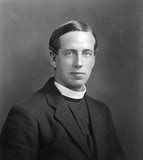 Ronald Arbuthnott Knox (17 February 1888 – 24 August 1957) was an English Catholic priest, theologian, radio broadcaster, and author of detective stories. He is known for his “Ten Commandments” of Detective Fiction that describe a philosophy of writing in which the reader can participate, attempting to find a solution to the mystery before the fictional detective reveals it.
Ronald Arbuthnott Knox (17 February 1888 – 24 August 1957) was an English Catholic priest, theologian, radio broadcaster, and author of detective stories. He is known for his “Ten Commandments” of Detective Fiction that describe a philosophy of writing in which the reader can participate, attempting to find a solution to the mystery before the fictional detective reveals it.
Ronald Knox was born into an Anglican family in Kibworth, Leicestershire, England. His strongly evangelical father was Edmund Arbuthnott Knox, who later became the Bishop of Manchester, and was a descendant of John Arbuthnott, 8th Viscount of Arbuthnott. The young Knox was educated at Eaton House, Summer Fields, and Eton College, where he took the first scholarship in 1900 and Balliol College, Oxford, where again he won the first classics scholarship in 1905. Knox, a brilliant classicist, won the Craven, the Hertford and the Ireland scholarships in classics, as well as the Gaisford Prize for Greek Verse Composition in 1908 and the Chancellor’s Prize for Latin Verse Composition in 1910. Aged 17, he privately vowed to remain celibate. In 1910, he became a fellow of Trinity College, Oxford.
Knox was ordained an Anglican priest in 1912 and was appointed chaplain of Trinity College. During World War I, he served in military intelligence. Knox resigned as Anglican chaplain in 1917 when he became a Roman Catholic. In response to Knox’s conversion to Roman Catholicism, his father cut him out of his will. In 1918 Knox was ordained a Roman Catholic priest and in 1919 joined the staff of St Edmund’s College, Ware, Hertfordshire, remaining there until 1926. Knox wrote and broadcast on Christianity and other subjects. While Roman Catholic chaplain at the University of Oxford (1926–1939) Knox published his first detective novel, The Viaduct Murder in 1925. Two more detective novels appeared in the 1920s (The Three Taps, 1927, and The Footsteps at the Lock, 1928), as well as Knox’s famous Detective Fiction Decalogue, wherein he laid down rules for the writing of detective fiction (all of which emphasized the puzzle aspect, or “fair play”. On the strength of these accomplishments, Father Knox was invited in 1930 to become a founding member of the Detection Club. Three more detective novels would follow — The Body in the Silo (1933), Still Dead (1934) and Double Cross Purposes (1937) — before Knox gave himself completely over to his religious scholarship.
He died on 24 August 1957, and his body was brought to Westminster Cathedral. Bishop Craven celebrated the Requiem Mass, at which Father Martin D’Arcy, a Jesuit, preached the panegyric. Knox was buried in the churchyard of St Andrew’s Church, Mells. (Sources: Wikipedia and The Passing Tramp)
The Body in the Silo and Still Dead are commonly considered to be Father Know’s best detective novels, though oddly and frustratingly, they are two of the most difficult to find. Both novels are well worth reading for fans of the pure puzzle sort of detective novel, as they have rigorous fair play problems and even include footnotes listing the pages where clues were earlier given. (The Passing Tramp) As of this writing Father Knox’s novels are available at The Murder Room in e-book and paperback format. (FantasticFiction).
Knox’s last novel, Double Cross Purposes (1937), is at its best in the lyrical description of a Highland Scotland setting in its opening (Chapters 1-5). These early chapters show Knox’s prose style at its witty best, as well. Like The Footsteps at the Lock, this too involves a river with an island. Both novels contain a map, with which the reader can follow all the action. A personal note: I found reading this book stimulating to my imagination, a very good thing. It is far from perfect, but it seems to suggest vistas and encourage one’s flight of fantasy. This is especially true of the opening chapters. (Mike Grost at A Guide to Classic Mystery and Detection).
(Facsimile Dust Jacket, Hodder & Stoughton (UK), 1937)
The Hon. Vernon Lethaby is a flamboyant, headline-seeking exhibitionist with extravagant tastes and an allowance that barely covers his racing debts. In an unlikely partnership with middle-aged Canadian adventurer Joe ‘Digger’ Henderson, he strikes out for the Highlands of Scotland to hunt for Prince Charlie’s treasure, which, according to legend, is interred on the isle of Erran. But Lathaby doesn’t trust his partner, and has taken out insurance to cover him against being swindled. Enter Miles Bredon, who is sent by his employer to ensure than neither of them defrauds the Indescribable Insurance Company. An unidentified body burned in a garage, maps, photographs and a missing key sustain this clever tale of financial skulduggery until the final pages. (The Murder Room)
Double Cross Purposes has been reviewed, among others, at My Reader’s Block, and Vintage Pop Fictions.


One thought on “Ronald A. Knox (1888 – 1957)”